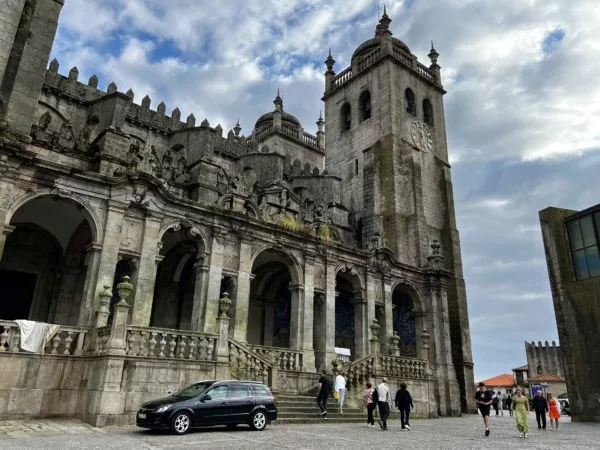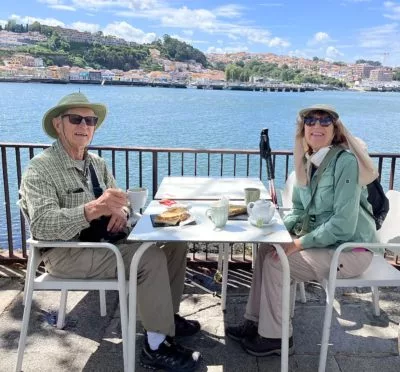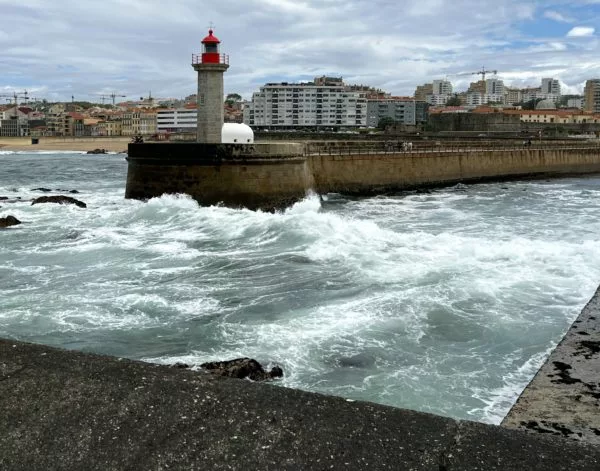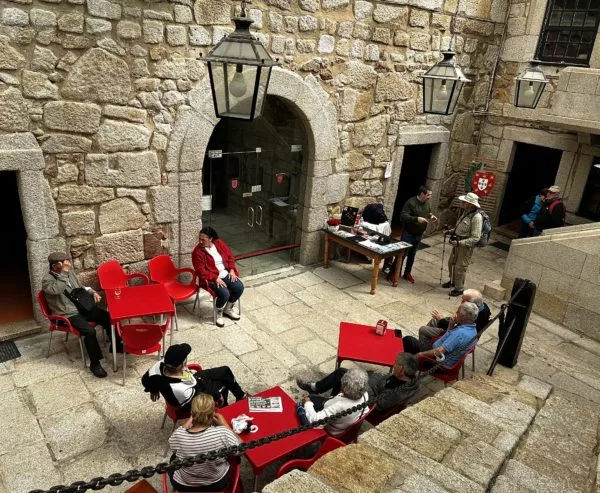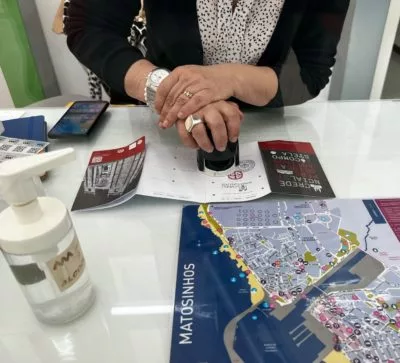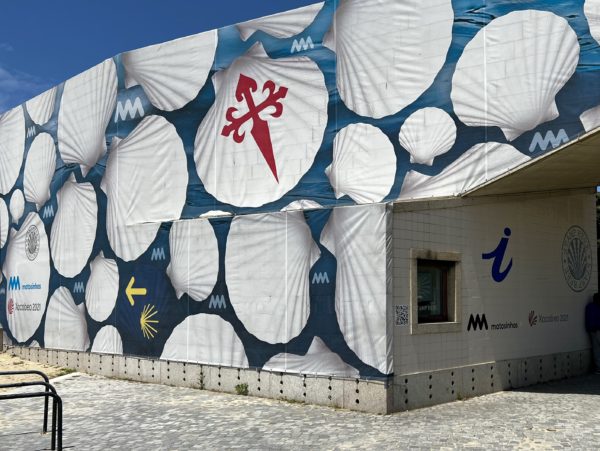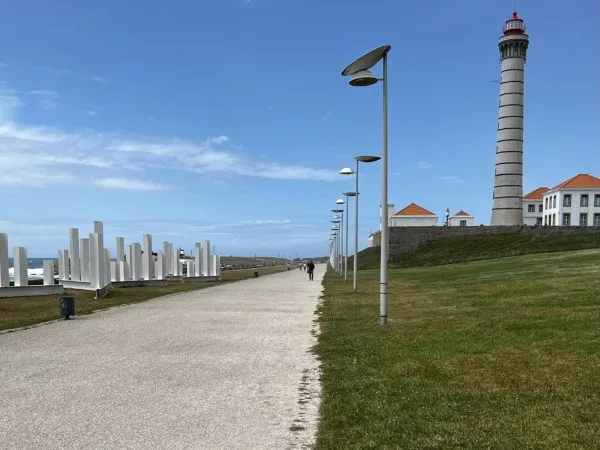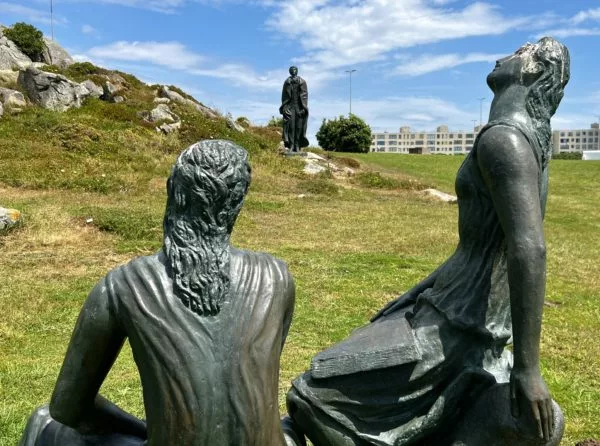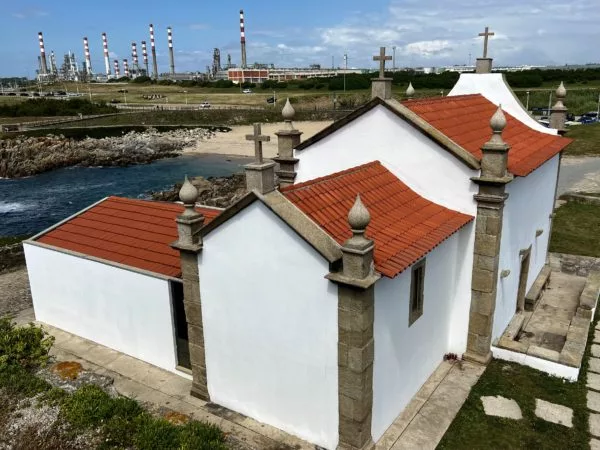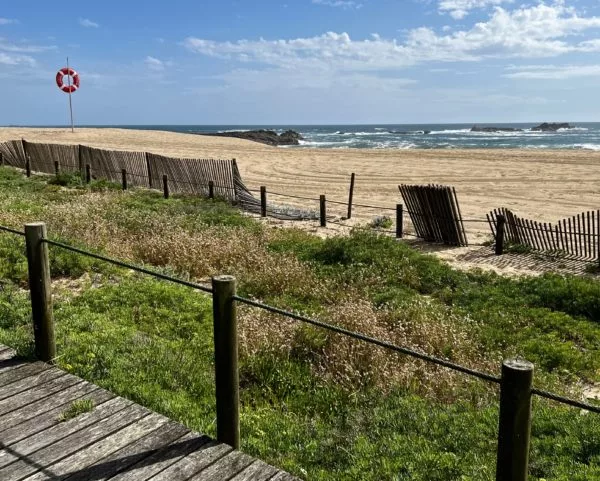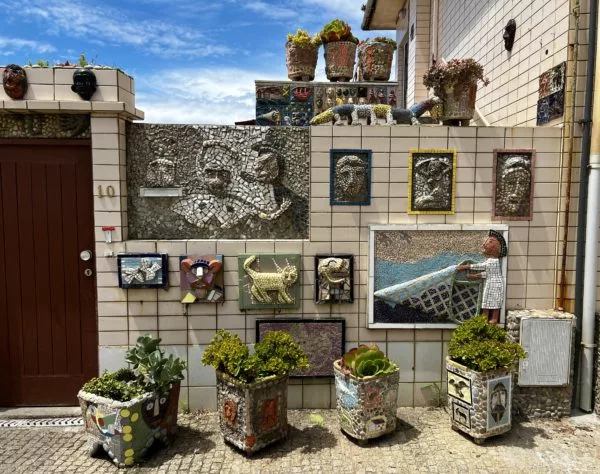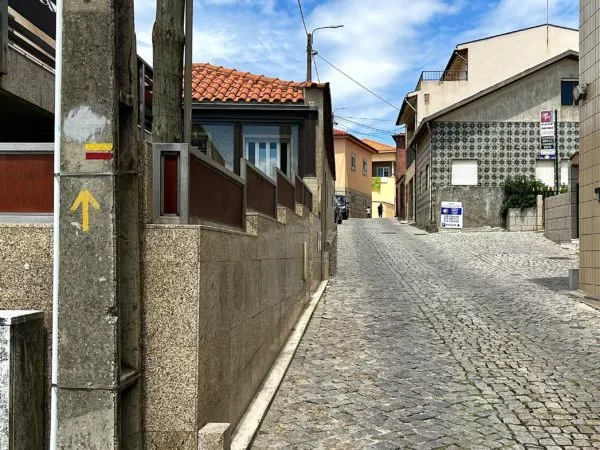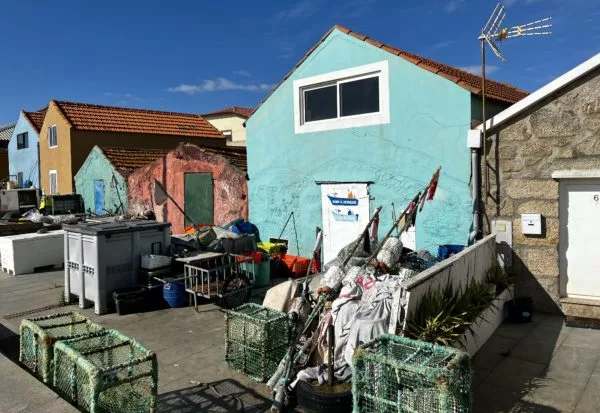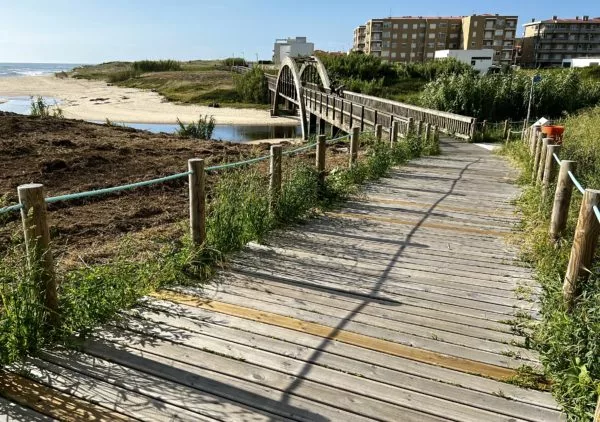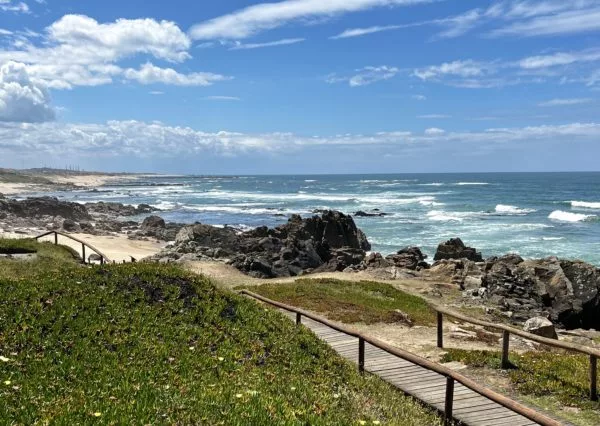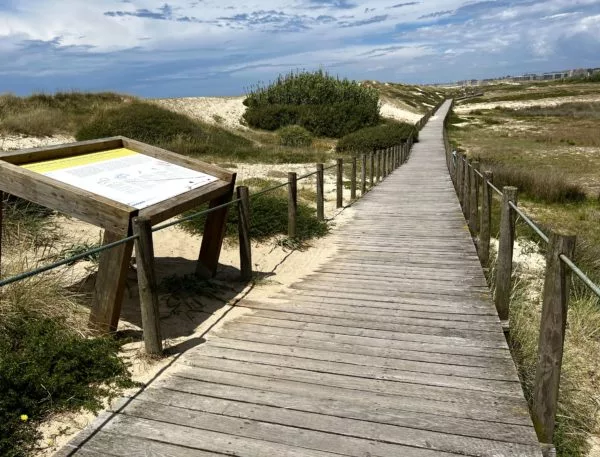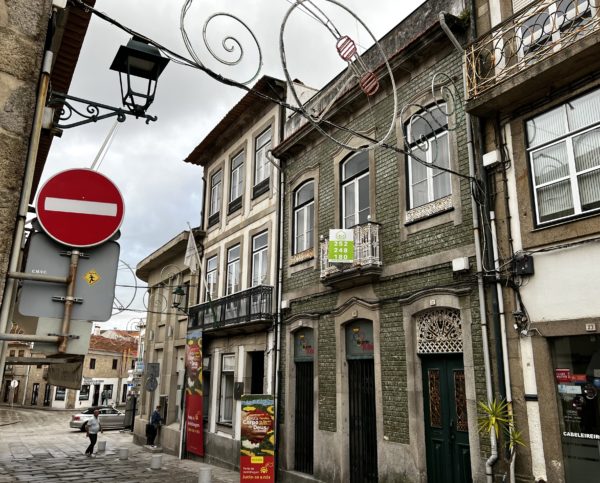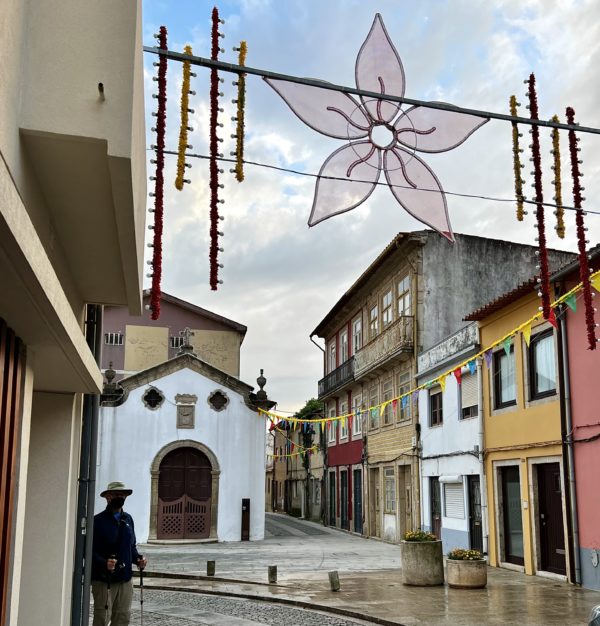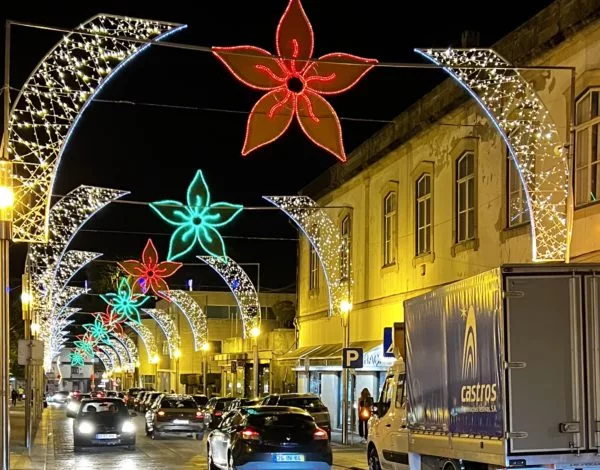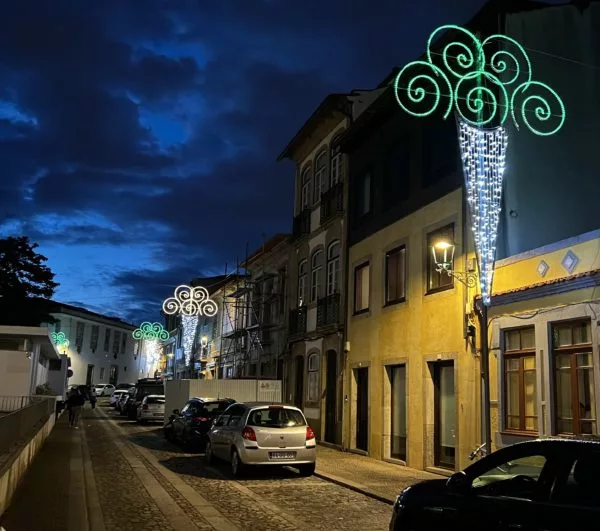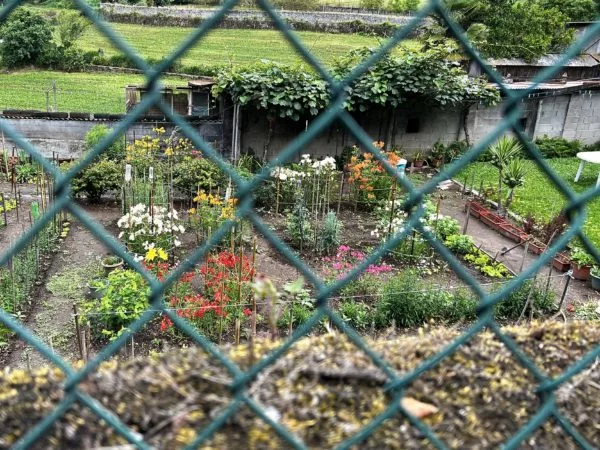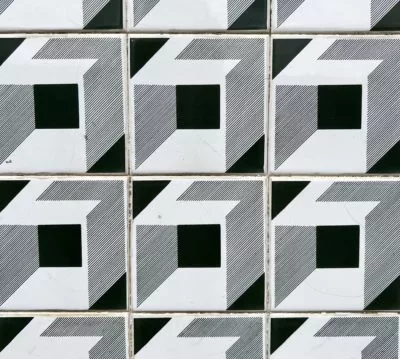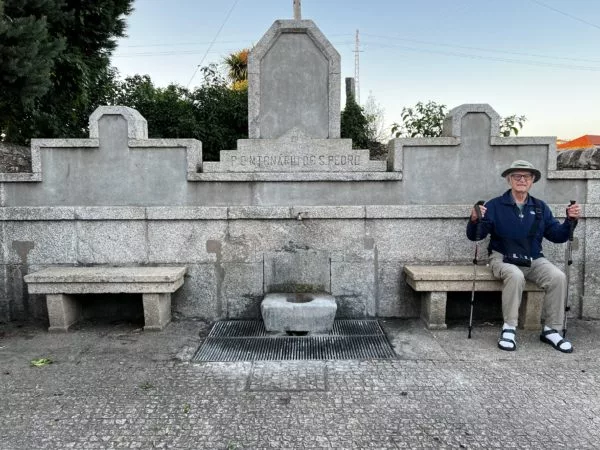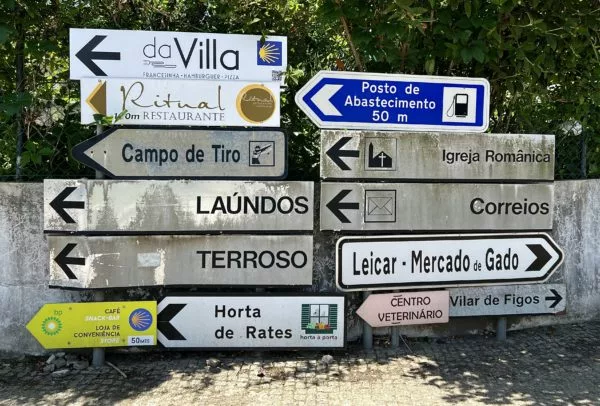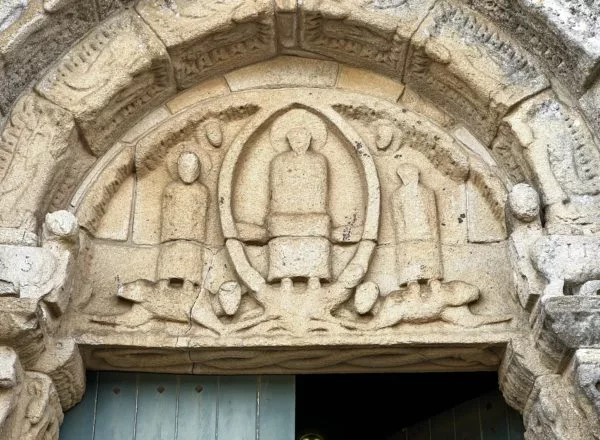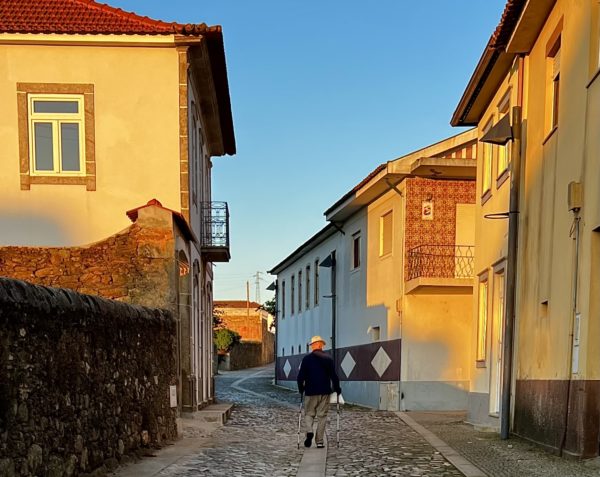
There are two coastal options, the Senda Litoral & the Caminho do Costa: the Senda Litoral directly follows along the beach while the Caminho do Costa can sometimes weave inland. The coastal stretch that we walked followed the Senda Litoral, and the Costa trail merged with it near the town of Vila do Conde. Check out route options & maps on Gronze.com & The Confraternity of St. James.
From San Diego we flew to Lisbon and spent a few days there sightseeing (and adjusting to the different time zone!) before taking a train up to Porto. A few more days of sightseeing and we were ready to begin walking. Around 162 miles (260 km) long, our walking itinerary was divided between Portugal & Spain. Regions included Galicia in Spain and Porto, Braga, & Viana do Castelo in Portugal. Landscapes encompassed charming vineyards, rushing streams, & shady forests. Abundant hospitality & Camino spirit prevailed. Bom Caminho & Buen Camino!
Porto’s Cathedral (Se do Porto) originated in the 12th c. and was built on the highest part of the city. Crenellations give the complex a fortress-like design.
Our journey officially started at the Cathedral. From there Dad & I wove down through streets to the Douro River that runs along the south side of Porto. Not many arrows were found for guidance, but as long as water was on the left, we were walking in the correct direction from the harbor.
Breakfast (toast, sandwich, tea, coffee) was at a picturesque outdoor cafe where boats glided by in the morning sunshine. It felt good to find this place after walking a while.
The first day of a Camino is significant — plan for the landscapes/historical sites/landmarks that will be encountered & also what services will be available (including water fountains), but then let the discoveries unfold serendipitously!
Boats along the harbor included the “water taxi” that transports passengers across the Douro River to Vila Nova de Gaia, which is known for port wine cellars. We took a cellar tour during our Porto stay & afterwards rode the taxi back across the river — a quick, fun ride!
Foz do Douro is the beach area where the river merges with the Atlantic. The lighthouse (Farolim de Felgueiras) had walkways with Porto’s coastline in view.
We stopped several times to watch swirling water & crashing waves spill over rocks — a dramatic seascape.
Lots of yellow at the Pergola da Foz promenade
Near Matosinhos, our destination for Day 1, locals were hanging out inside the Castle of the Cheese (Castelo do Queijo). This historic fort dates back to the 15th c. and was built on the site of an ancient Celtic settlement. In past centuries the structure served as a military base & an outlook during various time periods, including World War II. Today it’s a museum with a stairway that leads to the top deck where cannons still sit.
Credencial stamps (sellos) were given at the Matosinhos Information Center. It’s always exciting to get the first day’s stamp on a Camino. By the walk’s end, our credencials would be full of sellos & then presented at the Pilgrim’s Reception Office in Santiago to receive Compostelas (certificates of completion).
Shells covered the Information Center in Matosinhos.
The Farol de Leca (lighthouse) was along the wide promenade outside Matosinhos.
Sculptures of 19th c. Portuguese poet Antonio Nobre & his muses on a hillside by the lighthouse
Matosinhos’ beach district Leca da Palmeira looked surprisingly empty, perhaps because it was a weekday. In the distance stands the chapel Capela da Boa Nova built on top rocks.
Capela da Boa Nova (founded in 1392) once belonged to a Franciscan monastery. The oil refinery seen on the horizon is no longer in operation & will be transformed into a green neighborhood with housing, university campus, & a park.
The trail eventually became boardwalks that stretched for miles & miles — an amazing walkway system. They included ‘exit ramps’ down to the beach and also connected to oceanfront restaurants.
A house in Vila Cha featured mosaic artwork — very cool!
Walking through Vila Cha
Near Lavra there were colorful fishing huts, boats, & equipment. Portugal has a long history of fishing & fish dishes, especially cod (bacalhua), a staple found on many menus.
The Black Boot Bag takes a break at a fishing hut.
A sign pointed The Way on boardwalks outside Lavra, which is part of the Matosinhos municipality.
Lavra ahead
Dachshund Vasco greeted walkers at our lodging in Labruge where we spent the second night. Dad & I joked we were going to sneak him home, but it probably would have been difficult to carry Vasco all The Way! It’s rare to see walkers with their furry family members, but we’ve met several ‘canine pilgrims’ on other Caminos (one walker’s large dog even carried his own small ‘pack’).
For our Camino Portuguese lodging we chose to book rooms at hostels, pensions, hotels, etc. rather than stay at albergues because of Covid concerns. Although we missed albergues’ communal energy experienced on past walks, it was nice having our own bathrooms with regular size bath towels — a luxury! Privacy & downsized gear were appreciated — no need to bring sleeping bags/liners/throws & ‘camp’ towels.
More boardwalks!
Thus far, after two days on the trail, there were few other walkers seen — not unusual since the coastal paths are generally quieter than the Central Route (the second most popular behind Camino Frances.)
From LaBruge the boardwalks continued to Vila do Conde, one of Portugal’s oldest settlements and our last stop before crossing inland. The hotel was located adjacent to a marina & harbor plaza.
By chance we arrived during the Festival of St. John (Festa de Sao Joao), which happens in early June. Light displays decorated streets, and at night they illuminated the town.
An outdoor concert on the plaza added to the festivities, & the music could be heard through our room’s open window — a special cultural treat.
Aqueduto de Santa Clara is located next to the Monastery of Santa Clara, which overlooks Vila de Conde’s harbor. Completed in 1714, the aqueduct solved the monastery’s water shortage problems experienced since its origins in the 14th c. This historical structure spans 2.5 miles long and includes 999 arches — definitely worth climbing up a steep hill to see on the way out of town to the crossover path!
A bountiful garden in Junqueira — typical of gardens seen all along Camino Portuguese
Two crossover trail options were listed in guidebooks — the one we chose involved going through towns (including Junqueira) rather than an alternate path described as more remote with limited markers. However, on the Junqueira option there were a couple of confusing intersections — helpful locals pointed The Way (a dependable GPS/map app can be handy here). A few stretches included narrow walking spaces alongside roads, so it was a welcome sight to reach Arcos where the trail joined the Central Route.
In Arcos a wide stairway led up to the Church of St. Michael (Igreja de Sao Miguel). The building’s facade was covered with glazed ceramic tiles called azulejos (“polished stone”). They’re a Portuguese architectural tradition that dates back to the 13th c. & influenced by Byzantine & Roman mosaics. Besides giving a decorative quality, tiles also protected buildings from dampness & were used for temperature control.
Common tile designs depict religious/historical scenes, floral/foliage inspired patterns, & even modern geometric shapes, such as a cube pattern seen in Junqueira. This pattern reminded me of design projects I’ve assigned!
‘Casa’ style mailboxes were often seen in Portugal & are similar to ‘horreo‘ mailboxes found in Galicia. Horreos are granary storage buildings common in northern Spain and look ‘house-like.’
Dad refreshed at a fountain in Sao Pedro de Rates, where we stayed not far from Arcos.
Signs on the edge of Rates directed walkers to lodging, restaurants, and the Romanesque church, classified as a National Monument.
The Igreja de Sao Pedro de Rates is one of Portugal’s oldest Romanesque churches, & archeological excavations have uncovered Roman artifacts in its foundation. The West front portal shows a tympanum, or area above the doorway, that reflects its early art historical roots with simplified figures, including Christ in a mandorla.
The sun was setting in Rates on the stroll back to our lodging after dinner. The skies looked clear for the next day’s walk to the lovely city of Barcelos.

